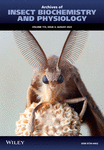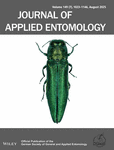Special Issues and Sections
Special section: Fall armyworm, Spodoptera frugiperda, in China
Guest editor: Prof. Le Kang and Prof. Huan-Ming Yang
The fall armyworm, Spodoptera frugiperda (J.E. Smith), is a major target pest of Bt crops (e.g., corn, cotton, and soybean) in North and South America. This pest has recently invaded Africa and Asia including China and the invasion has placed a great threat to the food security in many countries of these two continents. Due to the extensive use of Bt crops, practical resistance of S. frugiperda to Cry1F corn (TC 1507) with field control problems has widely occurred in Puerto Rico, Brazil, Argentina, and the mainland United States. Analyzing data generated from decade-long studies showed that several factors might have contributed to the wide development of the resistance... Read more
Special section: Insect microbiota-health and disease
Guest editor: Prof. Hong Yang and Prof. Sibao Wang
Insects live in incredibly complex environments. The intestinal epithelium of insects is in constant contact with microorganisms, some of which are beneficial and some harmful to the host. Insect gut health and function are maintained through multidimensional mechanisms that can proficiently remove foreign pathogenic microorganisms while effectively maintaining local symbiotic microbial homeostasis. The basic immune mechanisms of the insect gut, such as the dual oxidase–reactive oxygen species (Duox-ROS) system and the immune deficiency (Imd)-signaling pathway, are involved in the maintenance of microbial homeostasis... Read more
Special section: Endosymbionts and insect development
Guest editor: Prof. Xiao-Yue Hong
As one of the most successful intracellular symbiotic bacteria, Wolbachia can infect many arthropods and nematodes. Wolbachia infection usually affects the reproduction of their hosts to promote their own proliferation and transmission. Currently, most of the studies focus on the mechanisms of Wolbachia interactions with host reproduction. However, in addition to distribution in the reproductive tissues, Wolbachia also infect various somatic tissues of their hosts, including the brain. This raises the potential that Wolbachia may influence some somatic processes, such as behaviors in their hosts... Read more
Special Issue: Endosymbionts and insect development
In recent years, research in life sciences has been remarkably revolutionized owing to the establishment, development and application of genome editing technologies. Genome editing has not only accelerated fundamental research but has also shown promising applications in agricultural breeding and therapy.... Read more
Special section: The impact of transgenic crops on protected arthropods
Guest editor: Prof. Gabor L. Lovei
We review the postulated threatening processes that may have affected the decline in the eastern population of the monarch butterfly, Danaus plexippus L. (Lepidoptera: Nymphalidae), in North America. Although there are likely multiple contributing factors, such as climate and resource-related effects on breeding, migrating, and overwintering populations, the key landscape-level change appears to be associated with the widespread use of genetically modified herbicide resistant crops that have rapidly come to dominate the extensive core summer breeding range... Read more
Special section: Insects for food and feed
Guest editor: Long-Yu Zheng, Zi-Niu Yu and Jeffery K. Tomberlin
The use of edible insects has a long history in China, where they have been consumed for more than 2000 years. In general, the level of acceptance is high for the consumption of insects in China. Many studies on edible insects have been conducted in the last 20 years, and the scope of the research includes the culture of entomophagy and the identification, nutritional value, farming and breeding of edible insects, in addition to food production and safety... Read more








